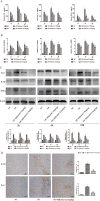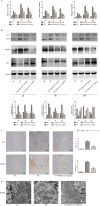The protective effects of shikonin on hepatic ischemia/reperfusion injury are mediated by the activation of the PI3K/Akt pathway
- PMID: 28322249
- PMCID: PMC5359611
- DOI: 10.1038/srep44785
The protective effects of shikonin on hepatic ischemia/reperfusion injury are mediated by the activation of the PI3K/Akt pathway
Abstract
Hepatic ischemia/reperfusion (I/R) injury, which can result in severe liver injury and dysfunction, occurs in a variety of conditions such as liver transplantation, shock, and trauma. Cell death in hepatic I/R injury has been linked to apoptosis and autophagy. Shikonin plays a significant protective role in ischemia/reperfusion injury. The purpose of the present study was to investigate the protective effect of shikonin on hepatic I/R injury and explore the underlying mechanism. Mice were subjected to segmental (70%) hepatic warm ischemia to induce hepatic I/R injury. Two doses of shikonin (7.5 and 12.5 mg/kg) were administered 2 h before surgery. Balb/c mice were randomly divided into four groups: normal control, I/R, and shikonin preconditioning at two doses (7.5 and 12.5 mg/kg). The serum and liver tissues were collected at three time points (3, 6, and 24 h). Shikonin significantly reduced serum AST and ALT levels and improved pathological features. Shikonin affected the expression of Bcl-2, Bax, caspase 3, caspase 9, Beclin-1, and LC3, and upregulated PI3K and p-Akt compared with the levels in the I/R group. Shikonin attenuated hepatic I/R injury by inhibiting apoptosis and autophagy through a mechanism involving the activation of PI3K/Akt signaling.
Conflict of interest statement
The authors declare no competing financial interests.
Figures







Similar articles
-
Protective Effects the Akt Activator SC79 in Hepatic Ischemia-Reperfusion Injury.Med Sci Monit. 2018 Jun 24;24:4346-4354. doi: 10.12659/MSM.911178. Med Sci Monit. 2018. PMID: 29936516 Free PMC article.
-
The role of AKT1 and autophagy in the protective effect of hydrogen sulphide against hepatic ischemia/reperfusion injury in mice.Autophagy. 2012 Jun;8(6):954-62. doi: 10.4161/auto.19927. Epub 2012 Jun 1. Autophagy. 2012. PMID: 22694815 Free PMC article.
-
15-Deoxy-Δ12,14-prostaglandin J2 alleviates hepatic ischemia-reperfusion injury in mice via inducing antioxidant response and inhibiting apoptosis and autophagy.Acta Pharmacol Sin. 2017 May;38(5):672-687. doi: 10.1038/aps.2016.108. Epub 2017 Feb 20. Acta Pharmacol Sin. 2017. PMID: 28216619 Free PMC article.
-
Role of the PI3K/Akt signaling pathway in liver ischemia reperfusion injury: a narrative review.Ann Palliat Med. 2022 Feb;11(2):806-817. doi: 10.21037/apm-21-3286. Epub 2021 Dec 27. Ann Palliat Med. 2022. PMID: 35016518 Review.
-
Regulation of autophagy protects against liver injury in liver surgery-induced ischaemia/reperfusion.J Cell Mol Med. 2021 Nov;25(21):9905-9917. doi: 10.1111/jcmm.16943. Epub 2021 Oct 8. J Cell Mol Med. 2021. PMID: 34626066 Free PMC article. Review.
Cited by
-
Cardioprotective effect of IGF-1 against myocardial ischemia/reperfusion injury through activation of PI3K/Akt pathway in rats in vivo.J Int Med Res. 2019 Aug;47(8):3886-3897. doi: 10.1177/0300060519857839. Epub 2019 Jul 25. J Int Med Res. 2019. PMID: 31342837 Free PMC article.
-
Shikonin Alleviates Gentamicin-Induced Renal Injury in Rats by Targeting Renal Endocytosis, SIRT1/Nrf2/HO-1, TLR-4/NF-κB/MAPK, and PI3K/Akt Cascades.Antibiotics (Basel). 2023 Apr 28;12(5):826. doi: 10.3390/antibiotics12050826. Antibiotics (Basel). 2023. PMID: 37237729 Free PMC article.
-
Natural compounds regulate the PI3K/Akt/GSK3β pathway in myocardial ischemia-reperfusion injury.Cell Cycle. 2023 Apr;22(7):741-757. doi: 10.1080/15384101.2022.2161959. Epub 2023 Jan 2. Cell Cycle. 2023. PMID: 36593695 Free PMC article.
-
Shikonin Protects PC12 Cells Against β-amyloid Peptide-Induced Cell Injury Through Antioxidant and Antiapoptotic Activities.Sci Rep. 2018 Jan 8;8(1):26. doi: 10.1038/s41598-017-18058-7. Sci Rep. 2018. PMID: 29311595 Free PMC article.
-
The liver protection of propylene glycol alginate sodium sulfate preconditioning against ischemia reperfusion injury: focusing MAPK pathway activity.Sci Rep. 2017 Nov 9;7(1):15175. doi: 10.1038/s41598-017-15521-3. Sci Rep. 2017. PMID: 29123239 Free PMC article.
References
-
- Selzner N., Rudiger H., Graf R. & Clavien P. A. Protective strategies against ischemic injury of the liver. Gastroenterology 125, 917 (2003). - PubMed
-
- Gao L. et al.. Caveolin-1 protects against hepatic ischemia/reperfusion injury through ameliorating peroxynitrite-mediated cell death. Free Radic Biol Med 95, 209 (2016). - PubMed
-
- Karatzas T., Neri A. A., Baibaki M. E. & Dontas I. A. Rodent models of hepatic ischemia-reperfusion injury: time and percentage-related pathophysiological mechanisms. J Surg Res 191, 399 (2014). - PubMed
-
- Czubkowski P., Socha P. & Pawlowska J. Oxidative stress in liver transplant recipients. Ann Transplant 16, 99 (2011). - PubMed
Publication types
MeSH terms
Substances
LinkOut - more resources
Full Text Sources
Other Literature Sources
Research Materials

